SolarEdge vs Enphase Energy: The Battle Continues
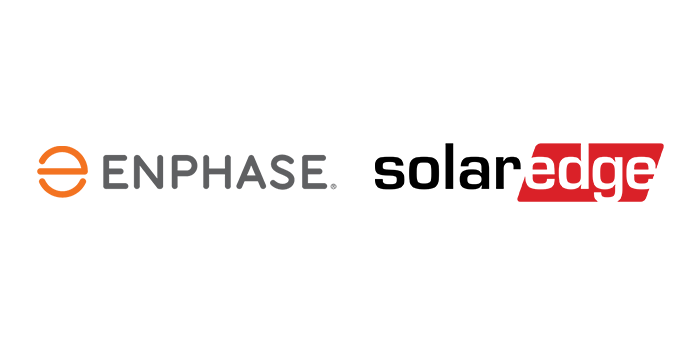
Which inverter wins the battle of module-level optimization?
With the inverter such a cornerstone component of your solar installation, it pays to take some time to find the best option for you. SolarEdge and Enphase both manufacture premium module-level inverters. But between SolarEdge vs Enphase, which one is better? Let’s walk through what makes each product unique and list their pros and cons to help you decide.
Why do SolarEdge and Enphase even exist?
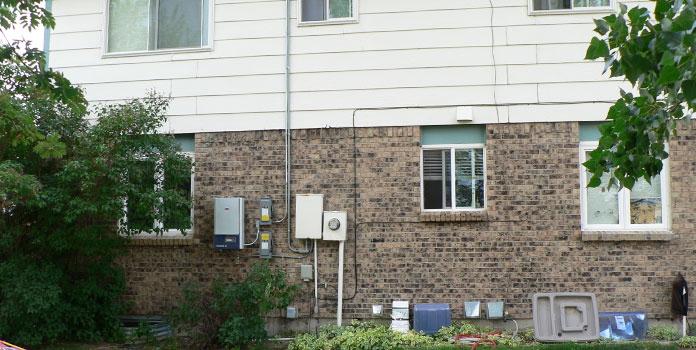
Before we even start talking about Solaredge vs Enphase, let’s ask the question, why do these special inverters even exist?
Solar panels produce direct current (DC) electricity. With DC, electrons can only move one direction (which is why it’s direct current). DC is efficient, but not quite as versatile as alternating current (AC), which allows electrons to move freely back and forth. Because of these benefits, our electricity grid and our homes use AC. But that raises issues. Our solar panels are DC, but homes are AC? What to do?
This is where inverters come in. Inverters convert the DC electricity your solar panels produce into AC power.
Most solar installations in the US use a string inverter (like in the image above, the inverter is the box on the far left), the simplest and most cost-effective inverter out there. With a string inverter, all the solar panels are connected together (like a daisy chain) and connected to the inverter, which treats all the individual panels as one giant solar panel.
String inverters are the cheapest type of inverter, but they certainly have their downsides:
- For the inverter to produce the maximum amount of power from the solar installation, all the solar panels must be placed on the same roof pitch, facing the same direction and same tilt. If you’ve got multiple, smaller roof sections, it will be difficult to find a single section that can house enough solar panels to cover your electricity use.
- Since all the panels are interconnected, even slight shade or shadow greatly affects the entire system’s electricity production. Even if just 10% of your installation is shaded, your total energy production can drop 50%! If you’ve got a giant tree that partially shades the roof where you’d like to place panels, a string inverter isn’t going to be your best choice.
- The inverter is a large metal box on the side of your house that can, depending on the model, make a slight humming noise. Whether this is an issue depends on the inverter location (next to your patio?) and your sensitivity to sounds – the humming really bothers some people, while others don’t even notice it.
SolarEdge and Enphase sprouted up to create inverters that solve these issues and that work better in complex situations. Let’s examine each company’s answer to these problems.
The Enphase Way
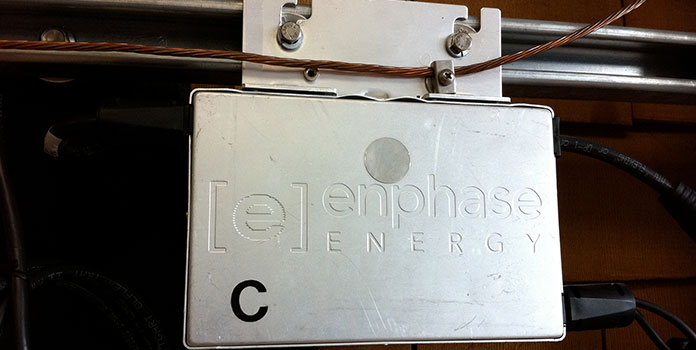
With their popular microinverter, Enphase went in and tackled all three of the issues above. With their system, each solar panel on your roof has a tiny little inverter placed under it (like in the image above). Each microinverter optimizes its individual solar panel, allowing Enphase to tackle each of the 3 problems we outlined above:
- With each panel optimized individually, homeowners are now free to place solar panels anywhere there’s roof space, regardless of direction. You could put 10 panels facing south, 5 panels facing east, and 2 panels facing west. Since each panel has its own microinverter, this sort of set-up is no problem!
- Again, with each panel optimized individually, if one is shaded or even malfunctioning, it doesn’t exponentially affect your installation’s overall production. You obviously lose the malfunctioning panel’s energy, but it won’t negatively affect any other panels’ production. If you’re worried about your neighbor’s trees covering up part of your solar installation, microinverters might be for you.
- With no central inverter on the side of the house, you don’t need to worry about an ungainly box next to your patio.
Enphase Energy has actually turned their microinverters into an all-in-one energy management offering, complete with solar and energy use monitoring as well as a battery storage option that pairs with the inverter system.
While Enphase is probably the most expensive inverter option out there, you’re certainly getting a product that performs well and makes your solar installation look great!
The SolarEdge Way
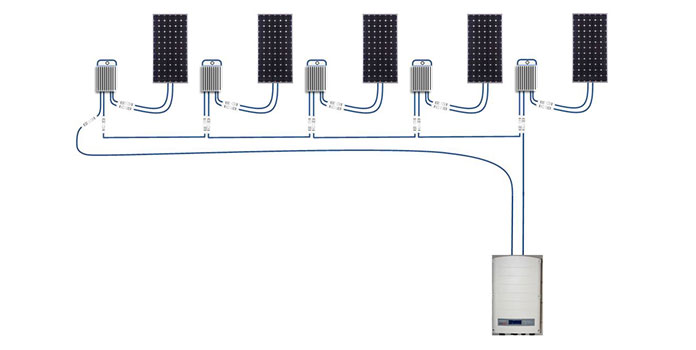
Just like Enphase, SolarEdge seeks to optimize solar installations so they produce more electricity than with a typical string inverter. Unlike Enphase’s microinverters though, SolarEdge produces an entire inverter ‘system’ that incorporates both a conventional string inverter installed on the side of the home as well as ‘power optimizers’ placed under each solar panel on the roof (similar to Enphase).
While the string inverter actually converts the electricity from DC to AC, the power optimizers are responsible for increasing each solar panel’s power output. Just like Enphase’s microinverters, the magic of SolarEdge’s power optimizers is in the numbers: each solar panel gets its own optimizer, allowing each panel to work at max efficiency.
With this set-up, SolarEdge knocks out issues #1 and #2 above. You are able to install on multiple sections of a roof and, with each panel optimized individually, shading has less of an effect on overall production. However, since SolarEdge uses a string inverter, issue #3 is still on the table (though we haven’t heard of any complaints regarding humming from SolarEdge inverters).
The benefit of SolarEdge’s unique optimizer/string inverter set-up is that you get the power optimization of microinverters, but at string inverters’ lower cost.
Just because Solaredge is a bit cheaper than Enphase doesn’t mean it doesn’t work as well. In 2013, SolarEdge actually studied shading on solar installations both with and without their system (see chart on page 5) and found that, with their power optimizers, the installations produced 8.4% more under heavy shading. Pretty cool!
Like Enphase, SolarEdge has created an entire ecosystem of products that all work together, including your inverter system, system monitoring, and integrated storage.
SolarEdge vs Enphase: Comparison of benefits
Now that we’ve run through how the products are different, let’s do a side-by-side comparison of the SolarEdge and Enphase products.
| Enphase | SolarEdge | |
| Cost | $$$ | $$ |
| Energy Production | Additional output due to module-level optimization | Additional output due to module-level optimization |
| Equipment | Module-Level Microinverters | Module-level Power Optimizers + Central String Inverter |
| Warranty | 25 years (warranty) | 25 years for power optimizers 12 years for inverter (warranty) |
| Battery Options | Stand-alone unit | Integrated into inverter |
| Market Share (Q1 2017, p7) | 27% | 26% |
As we already mentioned, SolarEdge is a medium-priced product that slides in between the more-expensive microinverters and the budget-conscious string inverters.
Both systems use module-level equipment to optimize solar panels individually, increasing energy production. Enphase offers a stellar 25 year warranty for its microinverters. SolarEdge offers 25 years for the power optimizers but only 12 for the inverter, meaning you’ll have to dish out another grand or two to replace that if it ever breaks (and inverters do break down, so budget that into your savings estimates).
Going down the list, you can see that both companies enjoy about the same market percentage. However, when we look at past performance (see link above for details), we see that Enphase – once the dominant module-level inverter system just 3 years ago – has fallen in popularity, while SolarEdge – over just a few years – has come to equally dominate.
The health of each company can be seen in their profits as well. In the first quarter of 2017, SolarEdge reported a net income of $14.2 million with $247 million in cash. Compare this to Enphase’s net loss of $23.3 million, with $30 million in cash. Keep in mind that with growth and R&D costs being so expensive, lots of solar companies are in a financial hole. Don’t look too much into these numbers – things could change.
But if you’re thinking long-term about your warranty and support (which you should), SolarEdge is looking much better than Enphase. If we had to guess who’ll be around in the future to service and repair your 25-year equipment, we know who we’d choose, but let’s ask the question anyway:
Who should you choose?
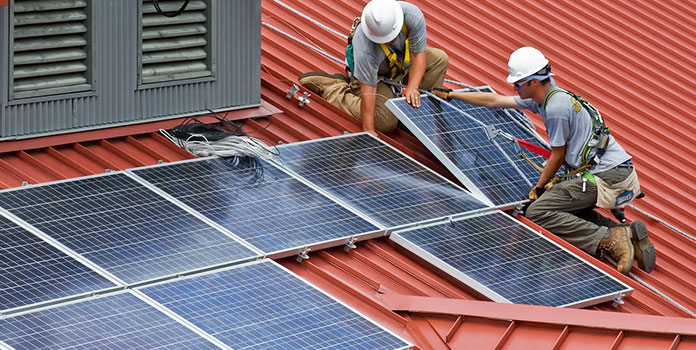
Despite what we discussed above, this is actually a pretty hard question to answer. First of all, both products perform remarkably well in their one sole purpose: to convert electricity from DC to AC power in the most efficient way possible. No matter what company you choose, you can rest assured you’re getting a great product that will do what they promise.
However, when you start looking at the other secondary factors, that’s when you need to start making a list of pros to help you decide between Solaredge vs enphase:
- Central Inverter – Enphase doesn’t need a central inverter, so you don’t have another big box on the side of your house. If it’s out of the way, that doesn’t matter. If it’s next to your patio, it could be an issue.
- Warranty – SolarEdge’s inverter warranty lasts only 12 years – pretty typical for string inverters. Enphase fully warranties the entire product for 25 years. However…
- Cost – Enphase is more expensive.
- Health of Business -From a business perspective, SolarEdge is performing much better than Enphase. This doesn’t really affect product quality, but you do need to know the company will be around in 25 years. Healthy companies last longer.
- Energy Storage – Lastly, if you want to add back-up storage to your installation down the road, Enphase offers stand-alone batteries. If you wanted to add storage to your SolarEdge system (and keep everything the same brand), you’d have to replace your inverter and buy their inverter+storage option.
Like we said, both are great options and they’re about equally popular on the market. What you decide is based on cost, benefits, and your own needs. If you still don’t know, write out a list of your own priorities to help you decide! And let us know your thoughts in the comments.
Want to read more about inverters? Check out these articles:
- The Enphase Microinverter: Reviews and Company Information
- What’s So Great About the SolarEdge Monitoring and Inverter System?
- Everything You Need to Know About Solar Inverter Types
Photo Credits under Public Domain via Wikimedia – 1a, 1b, 2, CC License via Wikimedia – 3, 4, & Flickr 5
